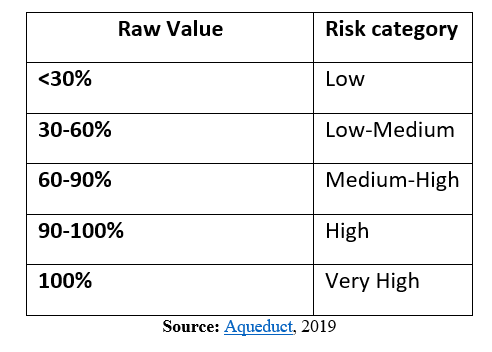Physical Risk Indicators Associated with Water Quality:
Water quality conditions are determined by the physical, chemical, biological and ecological characteristics, and by the assimilation and dilution capacity of the streams and bodies of water for the different types of pollutants.
The main pollutants, in terms of the magnitude of the load contributed to the surface water bodies, are: biodegradable and non-biodegradable organic matter, suspended solids and nutrients Toxic substances such as mercury from gold and silver mining processes and agrochemicals are also relevant.. Aspects in which the man to make investments to do water treatment to support the recovery and use of the water resource that a nation enjoys, analyzed from a positive point of view.
It is recommended to consider the indicators proposed by Aqueduct, a database created by the World Resoruce Institute in response to growing concerns from the private sector and other actors about water availability, water quality, climate change and growing demand. WaterProof makes use of Aqueduct data as well as associated quality indicators, including:
Untreated Connected Wastewater Indicator: This indicator measures the percentage of domestic wastewater that is connected through a sewer system and is not treated at least to a primary treatment level. The discharge of wastewater without adequate treatment could expose water bodies, the general public, and ecosystems to pollutants such as pathogens and nutrients. The indicator composes two crucial elements of wastewater management: connection and treatment. The low connection rates reflect the lack of access of households to public sewerage systems; the absence of at least one primary treatment reflects a country's lack of capacity (infrastructure, institutional knowledge) to treat wastewater. Together, these factors can indicate a country's current level of capacity to manage its domestic wastewater through two main pathways: extremely low connection rates (less than 1 percent) and high connection rates with little treatment. Higher values indicate higher percentages of point source wastewater discharged without treatment.
This indicator is estimated on an annual basis. The categorization for the level of risk that this indicator has is shown below:
Table 9. Level of risk Threat from connected untreated wastewater

Bibliography
WRI. AQUEDUCT 3.0: UPDATED DECISION-RELEVANT GLOBAL WATER RISK INDICATORS. 2021. World Resources Institute. | https://files.wri.org/s3fs-public/aqueduct-30-updated-decision-relevant-global-water-risk-indicators_1.pdf
Referencies
Collaborative on Health and the Environment (CHE) | https://www.healthandenvironment.org/environmental-health/environmental-risks/global-environment/water-quality